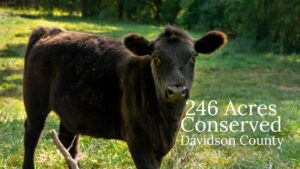
by Crystal Cockman
December 4, 2015

While out doing some bird banding, a common bird we caught in our mist-nets was the swamp sparrow (Melospiza georgiana). This bird breeds in eastern North America and Canada, and migrates to the southeastern United States.
Their primary habitat is marsh or swamp (particularly areas with cattail and sedges), including bogs and riparian areas along streams and ponds. In winter they can be found in thickets away from water, as well. They feed on aquatic invertebrates at water’s edge, but in winter they feed mostly on fruit and seeds.
They are a small songbird approximately 5 inches in length, with a solid gray chest, reddish wings, and white throat. During breeding season they also have a red cap. One noticeable feature when banding their legs is that they are long – longer than other species in their same genus, to allow them to wade in their marshy homes.
They are similar in color to Song and Lincoln’s sparrows but lack streaking on their chest. Their

call is a trill all on one note, similar to that of the chipping sparrow but slower. Males and females are similar in color pattern.
Swamp sparrows build their nest on the ground or just above the marsh and typically lay around four blueish-green eggs with brown spots. Their nesting season is June and July. The female is believed to build the nest, and she builds a new nest each year.
They are not typically found in groups, but rather travel singly or in pairs. The birds we caught in our nets were single birds. Part of a research project with the NC Museum of Natural Sciences, these birds received bands on their legs, and we recorded information such as fat stores and weight.

Swamp sparrows appear to be doing okay population wise, but habitat loss has affected them. They are another species impacted by loss of wetland habitats. Wetlands are important for a wide variety of plants and animals, and we should work to conserve them wherever possible.